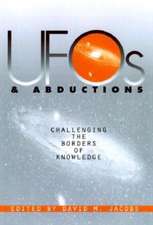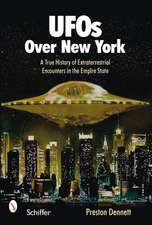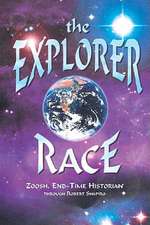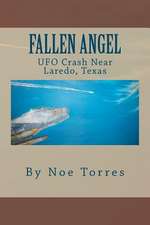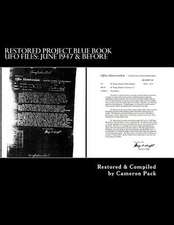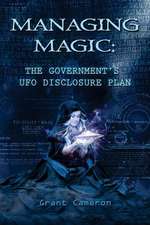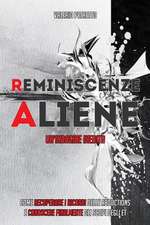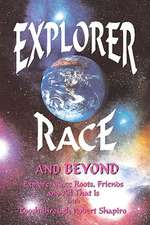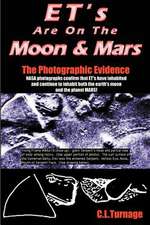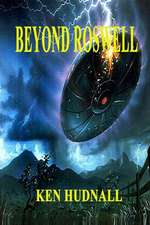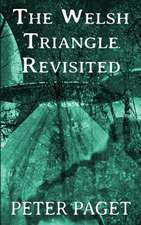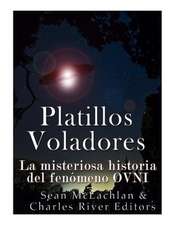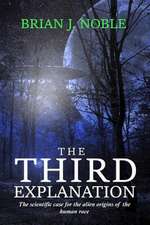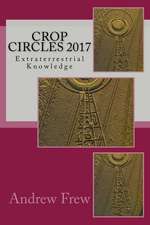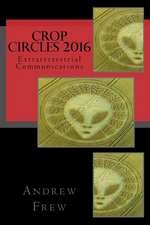Dreamland: Travels Inside the Secret World of Roswell and Area 51
Autor Phil Pattonen Limba Engleză Paperback – 30 apr 1999
A story of secrecy, suspicion, and conspiracy
A history of a place that does not legally exist
Dreamland zooms in on Area 51--the nearly four million acres of Nevada airspace that has been a base for experimental military aircraft, the fount of UFO rumors, and the alleged site of alien insurrection.
How this real-life legend came to exist is Phil Patton's tale. He explores the mystery and fantasy surrounding the place, peeks over the edge of paranoia, and tracks strange objects in the air above this country of the mind. He visits spies and counterspies, test pilots and secret agents, and tunnels into the subcultures of true believers and conspiracy buffs.
Reviewers have applauded Dreamland as "brilliant," "fascinating," "weird, wonderful, sometimes spooky," "curiously epic, frequently humorous, and always entertaining." Dreamland is a novelistic tour de force that makes us all rethink our convictions about American know-how--and alien inventiveness.
Preț: 116.96 lei
Nou
Puncte Express: 175
Preț estimativ în valută:
22.38€ • 23.28$ • 18.48£
22.38€ • 23.28$ • 18.48£
Carte disponibilă
Livrare economică 25 martie-08 aprilie
Preluare comenzi: 021 569.72.76
Specificații
ISBN-13: 9780375753855
ISBN-10: 0375753850
Pagini: 360
Ilustrații: 8-PP BLACK-&-WHITE INSERT
Dimensiuni: 158 x 223 x 22 mm
Greutate: 0.46 kg
Editura: Villard Books
ISBN-10: 0375753850
Pagini: 360
Ilustrații: 8-PP BLACK-&-WHITE INSERT
Dimensiuni: 158 x 223 x 22 mm
Greutate: 0.46 kg
Editura: Villard Books
Notă biografică
Phil Patton is a contributing editor of Esquire, Wired, and ID, and writes the "Public Eye" column for The New York Times. His previous books include Made in USA: The Secret Histories of the Things That Made America, Open Road: A Celebration of the American Highway, and Voyager (with Dick Rutan and Jeana Yeager). He has been a commentator on the CBS news show "Up to the Minute" and several public television series. Phil Patton can be reached at philpatton@msn.com.
Extras
Beyond the Jumbled Hills, in the wide Emigrant Valley of southern Nevada, bracketed by the Timpahute and Pahranagat ranges, lies Groom Lake, just one of many dry lakes that dot the desert reaches of Nevada and California, an expanse of white, hard alkaline soil--caliche soil. Rocky Mountain sheep and wild burros often wander onto its surface, and for years the bare weathered horned skull of a sheep sat here, a Western cliché as accent mark. Relentless winds lift small pebbles and drive them across the surface. Once or twice a year, a couple of inches of rain leave a thin liquid layer, a mock lake, shimmering and wavy, whose evaporation rapidly smoothes it to a high polish. The land sat like this for centuries before the asphalt and metal buildings, the wooden barracks and hangars, arrived, turning it into the Shangri-la, the Forbidden Temple of black, or secret, aircraft.
Groom Lake is set inside 4,742 square miles of restricted airspace, and nearly four million acres of bomb range--a space as big as a Benelux nation. It would come to be called by many names: Groom Lake, Watertown, Paradise Ranch, Home Base, Area 51. But the name for the airspace above the lake and the secret test facility and base that would grow there was, irresistibly, "Dreamland." It was this airspace that made it special, the airspace where strange craft appeared and disappeared like whims and suspicions, where speculations like airships glowed and hovered, then zipped off into the distance.
For years it had remained virtually unknown to the public that paid for it, its very existence denied by the government agencies and military contractors that ran it. It was illegal for those who worked inside to speak of it. And fighter pilots flying out of nearby Nellis Air Force Base were forbidden to cross into the Dreamland airspace. They called it "the Box," and if they strayed into it they were interrogated and grounded.
The most famous planes known to have flown at Dreamland were those created by the legendary Lockheed Skunk Works, established by Kelly Johnson. Yet Johnson's successor as the head of the Skunk Works, Ben Rich, told me shortly before his death in 1994, "I can't even say 'Groom Lake.' " To those in the know it was simply "the Ranch," or "the remote location."
A child of the Cold War, growing up fascinated with the mystique of aircraft, I knew the legend already: Here was where the U-2 first flew, and the SR-71 Blackbird and the F-117 Stealth fighter--all in secret. For years only a few grainy pictures of the place--taken surreptitiously from distant ridges or by satellites--served to prove its existence.
On the ridge above Dreamland, I would find I was not alone. Far from it. My fascination was shared by many others--airplane buffs, Skunkers, stealth chasers, Interceptors, like my friend Steve from Texas, like the journalist called the Minister of Words, guys with code names like Trader, Agent X, Zero, Bat, Fox, and others who gathered here, trying to find out about rumored, occasionally sighted, or speculated--upon planes called Aurora, Black Manta, Goldie, and "the mother ship."
Here, too, I encountered the UFO buffs--"the youfers," I would call them. By the late eighties, when a man named Bob Lazar emerged, claiming to have seen and worked on captured flying saucers, Area 51 had become one of the world's best-known UFO shrines.
To some it was the battlefield where the Cold War had been won, an antiwar fought with antiweapons: spy planes like the U-2 that saved us in Cuba in October 1962, or the Blackbird that defused the superpower confrontation in the Mideast in 1973. To one veteran, perhaps cynical, observer of the Pentagon, it was the symbol of a black world run amok, a cult of secrecy grown obsessive, "a secret city," "the last great preserve of cold warriors, a symbol for that wonderful secret world, a testament to how much fun it was to build hugely expensive planes and save the world." To another watcher who was obsessed by all the strange craft in the air, it was a site where "we are flight-testing vehicles that defy description, things so far beyond comprehension as to be really alien to our way of thinking."
To still others, Area 51 implied craft from beyond our planet, recovered in secrecy from desert crash sites or bequeathed in secret treaties with extraterrestrials--craft we were trying to learn how to fly ourselves. For some of the most extreme conspiracists, it was a place controlled by aliens: There had been a shoot-out, the darkest of the stories held, and the aliens who once dined side by side with earthlings in the base cafeteria were now in total control. Or perhaps, a final school argued, it was a place of the grandest deception, a shadowbox of saucer stories playing themselves out in a Punch-and-Judy performance designed to make us accept a final earthly tyranny.
Most of the flying saucers or mysterious lights were simply flares, the military argued, used to decoy missiles or illuminate targets at night, and it was plain that some were also landing lights seen through the distance of the rippling desert air. "Yeah, they are unidentified and they fly," one skeptic told me, "and they are sent by a mysterious alien civilization--the Pentagon."
But those watching for secret planes and those watching for alien craft appeared alike in their fascination and their procedures, in their careful accumulation of bits of knowledge, their descriptions of sightings, and, above all, their elusive dreams of a clear view, a clear video image, a clear photograph. "Mystery Aircraft," a 1992 report by the Federation of American Scientists, had observed a striking similarity between the spotters of secret planes and the UFO watchers. The FAS was dedicated to investigating Pentagon waste and excessive military secrecy, but now it had crossed into a new realm of philosophy and cultural analysis to argue that "it is useful to consider mystery aircraft not simply as an engineering product, but also as a sociological and epistemological phenomenon."
What had happened to Dreamland was a parable about knowledge and secrecy, about assembling facts and bits of information into a pattern, about learning and speculation. It was about what the Area 51 watcher known as PsychoSpy called "the nature of truth" but was perhaps closer to the opposite: the absence of certain truth and the abundance of uncertain lore, legend, and just plain "rumint," as the watchers on the Ridge liked to call it, echoing the military intelligence terms "photint," for photographic, "elint" for electronic, and "humint" for human forms of intelligence. "The signal-to-noise ratio is very low here," one stealth chaser told me. Or as Steve, the master Interceptor, put it in his Texas Panhandle locution, "It's awful tough to pick the pepper out of the shit."
It was about mystery engendering fantasy. It was like one of those empty spaces in the unexplored interiors of continents that medieval cartographers had imaginatively supplied with dragons and other monsters.
I had driven up from Las Vegas past the F-15s, F-16s, and B-1Bs landing and taking off at Nellis Air Force Base. A billboard for an upcoming air show at the base, sponsored by a large casino, promised "An American Dream Come True." The desert seemed like low-res detail on a flight simulator game: RISC landscape. This was the country for which God made cruise control. If you kept your eyes on the horizon, you barely seemed to move, so slowly did the distant perspective change. You had to focus on the shoulder, with its blur of sage and silver mileposts, to sense any progress.
Sometimes on that shoulder, sometimes on the road in front, my humped cartoon shadow ran ahead and reminded me of the exaggerated shadows of lunar or Mars landers, taking their own silhouetted pictures on some distant dry surface. After miles of tilted slabs of stone, striated like nicely cooked bacon, the only green area was a shock. The Pahranagat Valley looked like a dark Gothic 1840s vision of heaven, full of funeral urns and weeping willows, Protestant hymns and early deaths from typhoid. With its shallow lakes dotted with birds, it offered the richest land for hundreds of miles around. In the nineteenth century, horse rustlers used it to fatten animals stolen in Nevada, California, Utah, and even Arizona.
Past the valley, I came to the little town of Alamo, where someone wanted to sell a decrepit cafe, then climbed a long, looping stretch of road that crested in a high pass called Hancock Summit, where the road began to descend and the view opened ahead. I caught my breath as suddenly the curtain came up on a vast open westward view across a rising plain. A dusty white stick appeared pointing straight up in the air. A second later I recognized it as a gravel road, running so straight and so far and so directly up a slope miles away that in the perspective it seemed like a pole of swirling dust, no longer attached to the land but rising from it like a tightly spun tornado or dust devil.
This, I realized, was Groom Road, the cars sending up contrails of dust as they moved steadily down then up the slung valley, visible mile after mile but barely seeming to make any progress. It was the road that ran up over the Jumbled Hills into Dreamland.
We assembled at the trailhead in full view of the deadly force authorized and photography prohibited signs, beside the motor home that PsychoSpy, the self-appointed watchdog, ombudsman, and tour guide of Area 51, had made his base.
PsychoSpy was Glenn Campbell, author of The Area 51 Viewer's Guide, organizer of the Whitesides Defense Committee, publisher of the Desert Rat newsletter, the man who had discovered the closest and most accessible viewpoint. He named it "Freedom Ridge" and was delighted when he heard the local guards using that name on their radios. Once you could walk almost up to the base. But after too many curious citizens, including Greenpeace demonstrators protesting at the adjoining nuclear test site, had disturbed their privacy, the Air Force in 1984 went to the Bureau of Land Management, then to Congress, and had large tracts of public land around the base declared part of the Nellis Air Force Base Bomb and Gunnery Range. But two high points, which allowed a glimpse of the base to intrepid hikers, had remained accessible. By the late eighties, the spot began to draw crowds and television crews. That's when the legend began.
Now, in October 1993, the Air Force was applying to take over the viewpoints at Freedom Ridge, and Whitesides Mountain, too. We were heading for Freedom Ridge before it closed for a last chance to look into Dreamland.
Hiking up to Freedom Ridge, we dodged the brambly, fragrant sage and the fuzzy, Muppet-like Joshua trees and crossed rocks that seemed inscribed in some alien cuneiform. The perimeter of the base was marked by orange signposts running across the high desert and, on the other side of the barrier, strange-looking silver balls, the size of basketballs, on poles. The lore held that they were motion detectors or other sensors. Some claim that, thanks to ammonia sensors, these can sniff the difference between a human and a wandering cow or Rocky Mountain sheep. In any case, the exclusion of the public has made Dreamland a de facto wildlife preserve.
I had heard about the sensors and the video cameras and the road sensors, triggered by the weight of a passing vehicle. Helicopters would sweep along the border at sunrise to pick up anyone who had spent the night and sometimes "sandblast" them with downwash from the rotors. I had also heard of the men on the other side of the barrier, in their camouflage uniforms and white Jeep Cherokees, known locally as "camou dudes," who kept an eye on intruders and called in the local sheriff if any crossed the border.
So I kept my eye on the edge, marked with those strange silver balls, until the path rose more steeply and, surprisingly soon, we reached the top. And there it was: I thought of the moment in 20,000 Leagues Under the Sea when Nemo's men reach the crest of the atoll and suddenly see dozens of toiling figures down in the circular harbor.
It was all in sharper detail than I had anticipated. The base unfolded beneath us--a line of buildings, fuel tanks, an old bus, the big radar dish, an old bus, and a seven-mile runway--as well as the white horizontal of the dry lake itself. A Jeep came up the road far in the distance, then turned around after a while and left.
I kept finding myself looking back in the other direction, over the valley to the east where the long dirt road puffed up in dust as an occasional car passed. The rooster tails hung in the air a long time. The only black birds we saw were ravens--at sunset eight or a dozen spiraled in formation in the thermals at the edge of the rocks.
The ridge at the top was narrow, with a back like a whale, scattered with rocks and tufts of grass and the dead stalks of Joshua trees. It was impossible to pitch tents and hard to find flat places out of the wind wide enough for a sleeping bag. The rocks were black as if a fire had singed them.
I worked to wedge my sleeping bag in between the rocks before dark made it impossible to move. I sorted my gear: My flashlight still bore the masking tape that had identified it at summer camp as my daughter's. My rations were Yuppie MREs (Meals Ready to Eat): Power Bars and trail mix, with a self-indulgent Hershey bar thrown in.
I stood gazing quietly down at the base. "If there are extraterrestrials," the heavy man beside me said, "it would be the greatest discovery in human history. It would be an intellectual crime not to investigate." He was stern, almost lecturing. He had that chip on his shoulder common to conspiracy buffs. "Please let me finish," he would say too quickly when someone interjected an objection or comment.
We had all agreed not to carry cameras to the Ridge, but now he pulled one out and began snapping pictures. The fine print on the signs also forbade "sketching or drawing" the base, so the notebook and pen I carried would in theory make me equally subject to arrest.
"People get nervous when you mention the idea of extraterrestrials," he went on, while looking through his camera lens. The discovery of life on another planet would shake people's fundamental philosophical and religious assumptions, he said. It would demolish the conceit that we were the be-all and end-all of creation.
But it occurred to me: Rather than how would we explain the existence of other life forms to ourselves, how would we explain ourselves to them? What would they make of us? How could we sum up life here, give a summary of our situation now and the events of the previous half century?
The very possibility of such an encounter, like the prospect of Dreamland stretching out before us, suggested that the exercise of accounting for ourselves was a useful one: What exactly would we say to them? Would we explain the atomic bomb and the Cold War, the facing off of two earthly powers and the near destruction of the planet? Or, stranger yet, would we tell of the end of that war, and the deprivation many felt from its lack, the need for an enemy to define ourselves against?
Dreamland seemed an exemplary place to do this. I came to believe that its legend and lore, its language and paradoxes, provided a strange yet appropriate time capsule of a half century of cold war and black secrecy. Here, the cultures of nuclear power and airpower merged with the folklores of extraterrestrials and earthly conspiracies; their interference patterns formed a moiré of the weird. It was a place from which to see our own planet with the eyes of an outsider.
What you called the place revealed what you thought was flying there, and told who you were, just as whether you called a group of islands the Malvinas or the Falklands, whether you said "West Bank" or "Judea and Samaria" told who you were. People from the Skunk Works called it the Ranch or the remote location. At Nellis Air Force Base, it was the Box, or Red Square. And to hear someone refer to it as Area 51, the name used by the Atomic Energy Commission since the 1950s, meant that his interest was in the saucers. Beneath all these names, the place offered glimpses into the overlapping cultures of UFO lore, of Stealth craft, of nuclear energy and espionage, and into a world whose common ground was secrecy.
It was a think tank for Cold War engineering, but with the end of the Cold War--a war that produced its own versions of shell shock and battle fatigue--Dreamland was the center of a great network now in ruins.
Dreamland was the tabloid edge of technology, aptly sited near Las Vegas: It is to technology what Las Vegas is to the everyday economy. It was about playing the long odds. The engineers inside the hangars along Groom Lake were looking for "silver bullets," aiming to strike it rich with superplanes, to hit the jackpot of invincibility. The players were the most important ones in the military-industrial complex: Bechtel, E-Systems, TRW, Hughes, Lockheed, SAIC, and, perhaps the least known of all, EG&G.
Standing on the Ridge picking up lore, I learned about the company called Edgerton, Germeshausen & Grier (EG&G), which did all sorts of things at the test site, from photography to security. The company's founder, Harold Edgerton, was the MIT physicist and photo whiz best known for his stroboscopic photos of bullets passing through apples and milk drops caught in midsplash. He used this technique to photograph atomic explosions for the military and soon his company was providing a variety of services to the Air Force, to the CIA, and then to the Atomic Energy Commission. EG&G has a building at McCarran Airport in Las Vegas from which it operates the so-called Janet Airline of 727s that ferry workers--perhaps a thousand, perhaps two thousand--to and from Groom Lake. And it was EG&G, Bob Lazar claimed, that first interviewed him for a job working on flying saucers.
Another of Dreamland's contractors was Wackenhut, which provided security services--fences and alarms and guards. When Wackenhut was handling security, the guards on the perimeter were called Wackendudes. Then, when it became clear that most of them were from another agency, they became the camou dudes, or just "the dudes." Among those on the Ridge, the camou dudes grew to near mythical stature. Reports tended to wildly overstate their aggressiveness: Visitors were warned to avoid letting the sun glint off binocular or camera lenses, as if such a flash of light would draw M-16 fire. In fact, the fundamental condition of their jobs, as of those of most rent-a-cops, was tedium. Intruders were irritants and incidents meant paperwork. In the old days, they had ranged freely on public land, working on the principle of deterring the curious before they got near the perimeter. The camou dudes follow, lurk, and watch.
Wackenhut, which also ran the security force at the Nevada Test Site (NTS), had risen to the top of the rent-a-cop business. Like Bechtel or RAND or Mitre, it was one of the specialist organizations that grew up during the Cold War. George Wackenhut, an ambitious former FBI agent, joined with three other ex-agents in 1954 to form the private security agency. He was politically well connected and parlayed his friendships with Florida senator George Smathers, a carousing pal of JFK, and later Governor Claude Kirk, who did most of his carousing alone, into government contracts. An 1893 law, passed in resentment over the use of Pinkerton detectives to break strikes and protests, forbade the federal government to employ private detectives, but Wackenhut's lawyers found a loophole and the company managed to grab contracts for the Titan missile silos and Cape Canaveral. Soon Wackenhut guards were working not just for NASA but guarding embassies around the world, and sometimes handling jobs for the CIA and other agencies that wanted to keep their fingerprints off illicit arms shipments.
I had met Wackenhut men at the NTS and they looked like they spent more time working out than, say, reading. Dressed in temperate-zone camou in the middle of the desert, they did not seem to be students of the natural world around them either. Now that Wackenhut had shifted to an emphasis on more promising business strategies, such as operating prisons under contract for governments eager to "privatize," EG&G found itself in the security business too, supplying guards and even SWAT teams to NASA and DOE facilities.
But the camou dudes at Area 51 seemed to be a mixture of private guards and Air Force guards. PsychoSpy managed to discover--after one of the dudes flashed a Lincoln County deputy sheriff's ID while hassling him--that many of them were deputized by the local sheriff's department. Their notarized deputizations were public record, and he published many of their names.
If by some chance you should see something secret inside the perimeter, the required "oath upon inadvertent exposure" requires you to promise to remain silent, under threat of life imprisonment. Few trespassers were asked to sign it. They were generally charged in county court, fined, and released.
There were constant suggestions on how to get inside the perimeter. They were like a parody of the desperate efforts the CIA and Pentagon made in the 1940s and 1950s to get inside the "denied areas" of the Soviet Union and China, and seemed as wacky as the balloons of Project Mogul, as wild as LeMay's fleet of RB-47s over Vladivostok. The Interceptors figured as jesters in this court of the Cold War: They constantly discussed all kinds of spy schemes, using balloons, rocket gliders, or model car "rovers" with video cameras.
On the Ridge, black-plane buffs, true believing youfers, agnostics and skeptics, radio scanners and heavy optics fans, can mingle in the democracy of curiosity. Even old test pilots would come up here now and then and look at the runway from which they had once taken off. Eventually I became convinced that the two cultures--the stealthies and the youfers--were looking for the same thing.
Standing on the Ridge, I realized that its value grew not out of how much it let you see, but how little: how great the opportunity it created to imagine, fantasize, dream. The irony was that we were spying on spies, peeking in on remote locations at people and machines whose job was to peek in on remote locations. Some of us wore the same camou as the camou dudes, listened in on the same scanners, watched the watchers with the same nightscopes. Such spying was made possible by the Pentagon: by the Internet it had created and the computers its money had developed. In effect, we were self-made spies spying on real spies. And, I would find, others were spying on the spies spying on spies.
Dreamland had been created to devise spy planes to explore Soviet or Chinese missile or nuclear test sites. But in time, Dreamland took on the qualities of the areas it was created to expose--it resembled other, even more remote locations: Kapstan Yar, Tyuratum, Lop Nor. Conceived as a place to facilitate the "penetration of denied areas," it ended up itself behind a perimeter, a denied area.
The perimeter was only the most recent manifestation of our old friend the Frontier: the original settlement line, but also the New Frontier, the Last Frontier. It was the edge of the known, which meant it was the launching point for all sorts of explorations. It was full of the myth and mystery of any inaccessible country.
For a time, I thought of Dreamland as resembling the prints of Hiroshige, such as his Twenty-four Views of Edo, in which objects and structures in the foreground seem to get in the way of the views of the landscape. But after looking for a while at this art of "the floating world," as the Japanese call it, one understands that the foreground is also the subject.
Such views inspired Wallace Stevens's haiku-style poem "Thirteen Ways of Looking at a Blackbird." ("There were three blackbirds in a tree / Like a mind of three opinions.") It seemed to me, though, that looking at Dreamland was more like Stevens's jar in Tennessee, "taking dominion everywhere."
"The problem," the Minister would tell me in a phrase I could not forget, "is that the place has no edges."
The light began to fade, the warm sun to soften as it sank. The cold wind flickered around our limbs. We built a privy in a wedge of rocks, draped with a blue tarp for privacy. Two teens spoke in a controlled tone, curious, not fanatic, but credulous, too. They talked of hearing Lazar give a lecture. They spoke of Dulce, in New Mexico, where there were said to be--"were said" was a favorite youfer locution--dozens of aliens living underground. By one account they had massacred their guards and were in control of the complex. There was talk also of the Anthill, an underground installation near Tehachapi, California, and another underground base in that state at Helendale. Someone had been near Helendale recently, and there was talk of things flying in and out of apertures in the concrete at night. "Say there are dozens of aliens underground there too," one teen said, keeping all astonishment, all indications of belief or suspicion from his voice. "Say they're in full control."
As the sun went down, we built a fire, collecting stubs of Joshua trees that looked like soft, oversize pieces of coral but burned with surprising surges of flame and then a fitful glow.
The UFO types talked about Lazar. A fat girl talked about wanting to see strange things--not UFOs themselves, but weird UFO types.
As night fell, the lights came on in the base below, where personnel were probably watching television, amid the inevitable military tedium that attends even the most exotic of projects, more intently than they watched the few people, high above Dreamland, watching them.
The campsites were scattered, miscellaneous, like the social dynamic. In the middle of the night, I woke to hear the fat girl groping her way down the ridge, sleepless and grumbling.
I found myself drawn back again and again to the perimeter. One of the odd effects of visiting the Ridge was that it seemed to make visitors feel an impulse to investigate, in a vigilante way. So I came to fantasize: I saw myself as a mock version of one of those explorers charged by Congress and the Army Corps of Engineers to chart and record distant reaches of the West, men like John Wesley Powell or Clarence King. The idea of a travel account of a place you couldn't physically visit was irresistible. But I got a surprise: The place seemed to spin me away from me the more I found out about it. And I became more fascinated with the watchers than with watching.
There is an Indian petroglyph, a spiral, found on ancient rocks in the Nevada desert, that is thought to represent language. This would be my spiral: out and then in.
Groom Lake is set inside 4,742 square miles of restricted airspace, and nearly four million acres of bomb range--a space as big as a Benelux nation. It would come to be called by many names: Groom Lake, Watertown, Paradise Ranch, Home Base, Area 51. But the name for the airspace above the lake and the secret test facility and base that would grow there was, irresistibly, "Dreamland." It was this airspace that made it special, the airspace where strange craft appeared and disappeared like whims and suspicions, where speculations like airships glowed and hovered, then zipped off into the distance.
For years it had remained virtually unknown to the public that paid for it, its very existence denied by the government agencies and military contractors that ran it. It was illegal for those who worked inside to speak of it. And fighter pilots flying out of nearby Nellis Air Force Base were forbidden to cross into the Dreamland airspace. They called it "the Box," and if they strayed into it they were interrogated and grounded.
The most famous planes known to have flown at Dreamland were those created by the legendary Lockheed Skunk Works, established by Kelly Johnson. Yet Johnson's successor as the head of the Skunk Works, Ben Rich, told me shortly before his death in 1994, "I can't even say 'Groom Lake.' " To those in the know it was simply "the Ranch," or "the remote location."
A child of the Cold War, growing up fascinated with the mystique of aircraft, I knew the legend already: Here was where the U-2 first flew, and the SR-71 Blackbird and the F-117 Stealth fighter--all in secret. For years only a few grainy pictures of the place--taken surreptitiously from distant ridges or by satellites--served to prove its existence.
On the ridge above Dreamland, I would find I was not alone. Far from it. My fascination was shared by many others--airplane buffs, Skunkers, stealth chasers, Interceptors, like my friend Steve from Texas, like the journalist called the Minister of Words, guys with code names like Trader, Agent X, Zero, Bat, Fox, and others who gathered here, trying to find out about rumored, occasionally sighted, or speculated--upon planes called Aurora, Black Manta, Goldie, and "the mother ship."
Here, too, I encountered the UFO buffs--"the youfers," I would call them. By the late eighties, when a man named Bob Lazar emerged, claiming to have seen and worked on captured flying saucers, Area 51 had become one of the world's best-known UFO shrines.
To some it was the battlefield where the Cold War had been won, an antiwar fought with antiweapons: spy planes like the U-2 that saved us in Cuba in October 1962, or the Blackbird that defused the superpower confrontation in the Mideast in 1973. To one veteran, perhaps cynical, observer of the Pentagon, it was the symbol of a black world run amok, a cult of secrecy grown obsessive, "a secret city," "the last great preserve of cold warriors, a symbol for that wonderful secret world, a testament to how much fun it was to build hugely expensive planes and save the world." To another watcher who was obsessed by all the strange craft in the air, it was a site where "we are flight-testing vehicles that defy description, things so far beyond comprehension as to be really alien to our way of thinking."
To still others, Area 51 implied craft from beyond our planet, recovered in secrecy from desert crash sites or bequeathed in secret treaties with extraterrestrials--craft we were trying to learn how to fly ourselves. For some of the most extreme conspiracists, it was a place controlled by aliens: There had been a shoot-out, the darkest of the stories held, and the aliens who once dined side by side with earthlings in the base cafeteria were now in total control. Or perhaps, a final school argued, it was a place of the grandest deception, a shadowbox of saucer stories playing themselves out in a Punch-and-Judy performance designed to make us accept a final earthly tyranny.
Most of the flying saucers or mysterious lights were simply flares, the military argued, used to decoy missiles or illuminate targets at night, and it was plain that some were also landing lights seen through the distance of the rippling desert air. "Yeah, they are unidentified and they fly," one skeptic told me, "and they are sent by a mysterious alien civilization--the Pentagon."
But those watching for secret planes and those watching for alien craft appeared alike in their fascination and their procedures, in their careful accumulation of bits of knowledge, their descriptions of sightings, and, above all, their elusive dreams of a clear view, a clear video image, a clear photograph. "Mystery Aircraft," a 1992 report by the Federation of American Scientists, had observed a striking similarity between the spotters of secret planes and the UFO watchers. The FAS was dedicated to investigating Pentagon waste and excessive military secrecy, but now it had crossed into a new realm of philosophy and cultural analysis to argue that "it is useful to consider mystery aircraft not simply as an engineering product, but also as a sociological and epistemological phenomenon."
What had happened to Dreamland was a parable about knowledge and secrecy, about assembling facts and bits of information into a pattern, about learning and speculation. It was about what the Area 51 watcher known as PsychoSpy called "the nature of truth" but was perhaps closer to the opposite: the absence of certain truth and the abundance of uncertain lore, legend, and just plain "rumint," as the watchers on the Ridge liked to call it, echoing the military intelligence terms "photint," for photographic, "elint" for electronic, and "humint" for human forms of intelligence. "The signal-to-noise ratio is very low here," one stealth chaser told me. Or as Steve, the master Interceptor, put it in his Texas Panhandle locution, "It's awful tough to pick the pepper out of the shit."
It was about mystery engendering fantasy. It was like one of those empty spaces in the unexplored interiors of continents that medieval cartographers had imaginatively supplied with dragons and other monsters.
I had driven up from Las Vegas past the F-15s, F-16s, and B-1Bs landing and taking off at Nellis Air Force Base. A billboard for an upcoming air show at the base, sponsored by a large casino, promised "An American Dream Come True." The desert seemed like low-res detail on a flight simulator game: RISC landscape. This was the country for which God made cruise control. If you kept your eyes on the horizon, you barely seemed to move, so slowly did the distant perspective change. You had to focus on the shoulder, with its blur of sage and silver mileposts, to sense any progress.
Sometimes on that shoulder, sometimes on the road in front, my humped cartoon shadow ran ahead and reminded me of the exaggerated shadows of lunar or Mars landers, taking their own silhouetted pictures on some distant dry surface. After miles of tilted slabs of stone, striated like nicely cooked bacon, the only green area was a shock. The Pahranagat Valley looked like a dark Gothic 1840s vision of heaven, full of funeral urns and weeping willows, Protestant hymns and early deaths from typhoid. With its shallow lakes dotted with birds, it offered the richest land for hundreds of miles around. In the nineteenth century, horse rustlers used it to fatten animals stolen in Nevada, California, Utah, and even Arizona.
Past the valley, I came to the little town of Alamo, where someone wanted to sell a decrepit cafe, then climbed a long, looping stretch of road that crested in a high pass called Hancock Summit, where the road began to descend and the view opened ahead. I caught my breath as suddenly the curtain came up on a vast open westward view across a rising plain. A dusty white stick appeared pointing straight up in the air. A second later I recognized it as a gravel road, running so straight and so far and so directly up a slope miles away that in the perspective it seemed like a pole of swirling dust, no longer attached to the land but rising from it like a tightly spun tornado or dust devil.
This, I realized, was Groom Road, the cars sending up contrails of dust as they moved steadily down then up the slung valley, visible mile after mile but barely seeming to make any progress. It was the road that ran up over the Jumbled Hills into Dreamland.
We assembled at the trailhead in full view of the deadly force authorized and photography prohibited signs, beside the motor home that PsychoSpy, the self-appointed watchdog, ombudsman, and tour guide of Area 51, had made his base.
PsychoSpy was Glenn Campbell, author of The Area 51 Viewer's Guide, organizer of the Whitesides Defense Committee, publisher of the Desert Rat newsletter, the man who had discovered the closest and most accessible viewpoint. He named it "Freedom Ridge" and was delighted when he heard the local guards using that name on their radios. Once you could walk almost up to the base. But after too many curious citizens, including Greenpeace demonstrators protesting at the adjoining nuclear test site, had disturbed their privacy, the Air Force in 1984 went to the Bureau of Land Management, then to Congress, and had large tracts of public land around the base declared part of the Nellis Air Force Base Bomb and Gunnery Range. But two high points, which allowed a glimpse of the base to intrepid hikers, had remained accessible. By the late eighties, the spot began to draw crowds and television crews. That's when the legend began.
Now, in October 1993, the Air Force was applying to take over the viewpoints at Freedom Ridge, and Whitesides Mountain, too. We were heading for Freedom Ridge before it closed for a last chance to look into Dreamland.
Hiking up to Freedom Ridge, we dodged the brambly, fragrant sage and the fuzzy, Muppet-like Joshua trees and crossed rocks that seemed inscribed in some alien cuneiform. The perimeter of the base was marked by orange signposts running across the high desert and, on the other side of the barrier, strange-looking silver balls, the size of basketballs, on poles. The lore held that they were motion detectors or other sensors. Some claim that, thanks to ammonia sensors, these can sniff the difference between a human and a wandering cow or Rocky Mountain sheep. In any case, the exclusion of the public has made Dreamland a de facto wildlife preserve.
I had heard about the sensors and the video cameras and the road sensors, triggered by the weight of a passing vehicle. Helicopters would sweep along the border at sunrise to pick up anyone who had spent the night and sometimes "sandblast" them with downwash from the rotors. I had also heard of the men on the other side of the barrier, in their camouflage uniforms and white Jeep Cherokees, known locally as "camou dudes," who kept an eye on intruders and called in the local sheriff if any crossed the border.
So I kept my eye on the edge, marked with those strange silver balls, until the path rose more steeply and, surprisingly soon, we reached the top. And there it was: I thought of the moment in 20,000 Leagues Under the Sea when Nemo's men reach the crest of the atoll and suddenly see dozens of toiling figures down in the circular harbor.
It was all in sharper detail than I had anticipated. The base unfolded beneath us--a line of buildings, fuel tanks, an old bus, the big radar dish, an old bus, and a seven-mile runway--as well as the white horizontal of the dry lake itself. A Jeep came up the road far in the distance, then turned around after a while and left.
I kept finding myself looking back in the other direction, over the valley to the east where the long dirt road puffed up in dust as an occasional car passed. The rooster tails hung in the air a long time. The only black birds we saw were ravens--at sunset eight or a dozen spiraled in formation in the thermals at the edge of the rocks.
The ridge at the top was narrow, with a back like a whale, scattered with rocks and tufts of grass and the dead stalks of Joshua trees. It was impossible to pitch tents and hard to find flat places out of the wind wide enough for a sleeping bag. The rocks were black as if a fire had singed them.
I worked to wedge my sleeping bag in between the rocks before dark made it impossible to move. I sorted my gear: My flashlight still bore the masking tape that had identified it at summer camp as my daughter's. My rations were Yuppie MREs (Meals Ready to Eat): Power Bars and trail mix, with a self-indulgent Hershey bar thrown in.
I stood gazing quietly down at the base. "If there are extraterrestrials," the heavy man beside me said, "it would be the greatest discovery in human history. It would be an intellectual crime not to investigate." He was stern, almost lecturing. He had that chip on his shoulder common to conspiracy buffs. "Please let me finish," he would say too quickly when someone interjected an objection or comment.
We had all agreed not to carry cameras to the Ridge, but now he pulled one out and began snapping pictures. The fine print on the signs also forbade "sketching or drawing" the base, so the notebook and pen I carried would in theory make me equally subject to arrest.
"People get nervous when you mention the idea of extraterrestrials," he went on, while looking through his camera lens. The discovery of life on another planet would shake people's fundamental philosophical and religious assumptions, he said. It would demolish the conceit that we were the be-all and end-all of creation.
But it occurred to me: Rather than how would we explain the existence of other life forms to ourselves, how would we explain ourselves to them? What would they make of us? How could we sum up life here, give a summary of our situation now and the events of the previous half century?
The very possibility of such an encounter, like the prospect of Dreamland stretching out before us, suggested that the exercise of accounting for ourselves was a useful one: What exactly would we say to them? Would we explain the atomic bomb and the Cold War, the facing off of two earthly powers and the near destruction of the planet? Or, stranger yet, would we tell of the end of that war, and the deprivation many felt from its lack, the need for an enemy to define ourselves against?
Dreamland seemed an exemplary place to do this. I came to believe that its legend and lore, its language and paradoxes, provided a strange yet appropriate time capsule of a half century of cold war and black secrecy. Here, the cultures of nuclear power and airpower merged with the folklores of extraterrestrials and earthly conspiracies; their interference patterns formed a moiré of the weird. It was a place from which to see our own planet with the eyes of an outsider.
What you called the place revealed what you thought was flying there, and told who you were, just as whether you called a group of islands the Malvinas or the Falklands, whether you said "West Bank" or "Judea and Samaria" told who you were. People from the Skunk Works called it the Ranch or the remote location. At Nellis Air Force Base, it was the Box, or Red Square. And to hear someone refer to it as Area 51, the name used by the Atomic Energy Commission since the 1950s, meant that his interest was in the saucers. Beneath all these names, the place offered glimpses into the overlapping cultures of UFO lore, of Stealth craft, of nuclear energy and espionage, and into a world whose common ground was secrecy.
It was a think tank for Cold War engineering, but with the end of the Cold War--a war that produced its own versions of shell shock and battle fatigue--Dreamland was the center of a great network now in ruins.
Dreamland was the tabloid edge of technology, aptly sited near Las Vegas: It is to technology what Las Vegas is to the everyday economy. It was about playing the long odds. The engineers inside the hangars along Groom Lake were looking for "silver bullets," aiming to strike it rich with superplanes, to hit the jackpot of invincibility. The players were the most important ones in the military-industrial complex: Bechtel, E-Systems, TRW, Hughes, Lockheed, SAIC, and, perhaps the least known of all, EG&G.
Standing on the Ridge picking up lore, I learned about the company called Edgerton, Germeshausen & Grier (EG&G), which did all sorts of things at the test site, from photography to security. The company's founder, Harold Edgerton, was the MIT physicist and photo whiz best known for his stroboscopic photos of bullets passing through apples and milk drops caught in midsplash. He used this technique to photograph atomic explosions for the military and soon his company was providing a variety of services to the Air Force, to the CIA, and then to the Atomic Energy Commission. EG&G has a building at McCarran Airport in Las Vegas from which it operates the so-called Janet Airline of 727s that ferry workers--perhaps a thousand, perhaps two thousand--to and from Groom Lake. And it was EG&G, Bob Lazar claimed, that first interviewed him for a job working on flying saucers.
Another of Dreamland's contractors was Wackenhut, which provided security services--fences and alarms and guards. When Wackenhut was handling security, the guards on the perimeter were called Wackendudes. Then, when it became clear that most of them were from another agency, they became the camou dudes, or just "the dudes." Among those on the Ridge, the camou dudes grew to near mythical stature. Reports tended to wildly overstate their aggressiveness: Visitors were warned to avoid letting the sun glint off binocular or camera lenses, as if such a flash of light would draw M-16 fire. In fact, the fundamental condition of their jobs, as of those of most rent-a-cops, was tedium. Intruders were irritants and incidents meant paperwork. In the old days, they had ranged freely on public land, working on the principle of deterring the curious before they got near the perimeter. The camou dudes follow, lurk, and watch.
Wackenhut, which also ran the security force at the Nevada Test Site (NTS), had risen to the top of the rent-a-cop business. Like Bechtel or RAND or Mitre, it was one of the specialist organizations that grew up during the Cold War. George Wackenhut, an ambitious former FBI agent, joined with three other ex-agents in 1954 to form the private security agency. He was politically well connected and parlayed his friendships with Florida senator George Smathers, a carousing pal of JFK, and later Governor Claude Kirk, who did most of his carousing alone, into government contracts. An 1893 law, passed in resentment over the use of Pinkerton detectives to break strikes and protests, forbade the federal government to employ private detectives, but Wackenhut's lawyers found a loophole and the company managed to grab contracts for the Titan missile silos and Cape Canaveral. Soon Wackenhut guards were working not just for NASA but guarding embassies around the world, and sometimes handling jobs for the CIA and other agencies that wanted to keep their fingerprints off illicit arms shipments.
I had met Wackenhut men at the NTS and they looked like they spent more time working out than, say, reading. Dressed in temperate-zone camou in the middle of the desert, they did not seem to be students of the natural world around them either. Now that Wackenhut had shifted to an emphasis on more promising business strategies, such as operating prisons under contract for governments eager to "privatize," EG&G found itself in the security business too, supplying guards and even SWAT teams to NASA and DOE facilities.
But the camou dudes at Area 51 seemed to be a mixture of private guards and Air Force guards. PsychoSpy managed to discover--after one of the dudes flashed a Lincoln County deputy sheriff's ID while hassling him--that many of them were deputized by the local sheriff's department. Their notarized deputizations were public record, and he published many of their names.
If by some chance you should see something secret inside the perimeter, the required "oath upon inadvertent exposure" requires you to promise to remain silent, under threat of life imprisonment. Few trespassers were asked to sign it. They were generally charged in county court, fined, and released.
There were constant suggestions on how to get inside the perimeter. They were like a parody of the desperate efforts the CIA and Pentagon made in the 1940s and 1950s to get inside the "denied areas" of the Soviet Union and China, and seemed as wacky as the balloons of Project Mogul, as wild as LeMay's fleet of RB-47s over Vladivostok. The Interceptors figured as jesters in this court of the Cold War: They constantly discussed all kinds of spy schemes, using balloons, rocket gliders, or model car "rovers" with video cameras.
On the Ridge, black-plane buffs, true believing youfers, agnostics and skeptics, radio scanners and heavy optics fans, can mingle in the democracy of curiosity. Even old test pilots would come up here now and then and look at the runway from which they had once taken off. Eventually I became convinced that the two cultures--the stealthies and the youfers--were looking for the same thing.
Standing on the Ridge, I realized that its value grew not out of how much it let you see, but how little: how great the opportunity it created to imagine, fantasize, dream. The irony was that we were spying on spies, peeking in on remote locations at people and machines whose job was to peek in on remote locations. Some of us wore the same camou as the camou dudes, listened in on the same scanners, watched the watchers with the same nightscopes. Such spying was made possible by the Pentagon: by the Internet it had created and the computers its money had developed. In effect, we were self-made spies spying on real spies. And, I would find, others were spying on the spies spying on spies.
Dreamland had been created to devise spy planes to explore Soviet or Chinese missile or nuclear test sites. But in time, Dreamland took on the qualities of the areas it was created to expose--it resembled other, even more remote locations: Kapstan Yar, Tyuratum, Lop Nor. Conceived as a place to facilitate the "penetration of denied areas," it ended up itself behind a perimeter, a denied area.
The perimeter was only the most recent manifestation of our old friend the Frontier: the original settlement line, but also the New Frontier, the Last Frontier. It was the edge of the known, which meant it was the launching point for all sorts of explorations. It was full of the myth and mystery of any inaccessible country.
For a time, I thought of Dreamland as resembling the prints of Hiroshige, such as his Twenty-four Views of Edo, in which objects and structures in the foreground seem to get in the way of the views of the landscape. But after looking for a while at this art of "the floating world," as the Japanese call it, one understands that the foreground is also the subject.
Such views inspired Wallace Stevens's haiku-style poem "Thirteen Ways of Looking at a Blackbird." ("There were three blackbirds in a tree / Like a mind of three opinions.") It seemed to me, though, that looking at Dreamland was more like Stevens's jar in Tennessee, "taking dominion everywhere."
"The problem," the Minister would tell me in a phrase I could not forget, "is that the place has no edges."
The light began to fade, the warm sun to soften as it sank. The cold wind flickered around our limbs. We built a privy in a wedge of rocks, draped with a blue tarp for privacy. Two teens spoke in a controlled tone, curious, not fanatic, but credulous, too. They talked of hearing Lazar give a lecture. They spoke of Dulce, in New Mexico, where there were said to be--"were said" was a favorite youfer locution--dozens of aliens living underground. By one account they had massacred their guards and were in control of the complex. There was talk also of the Anthill, an underground installation near Tehachapi, California, and another underground base in that state at Helendale. Someone had been near Helendale recently, and there was talk of things flying in and out of apertures in the concrete at night. "Say there are dozens of aliens underground there too," one teen said, keeping all astonishment, all indications of belief or suspicion from his voice. "Say they're in full control."
As the sun went down, we built a fire, collecting stubs of Joshua trees that looked like soft, oversize pieces of coral but burned with surprising surges of flame and then a fitful glow.
The UFO types talked about Lazar. A fat girl talked about wanting to see strange things--not UFOs themselves, but weird UFO types.
As night fell, the lights came on in the base below, where personnel were probably watching television, amid the inevitable military tedium that attends even the most exotic of projects, more intently than they watched the few people, high above Dreamland, watching them.
The campsites were scattered, miscellaneous, like the social dynamic. In the middle of the night, I woke to hear the fat girl groping her way down the ridge, sleepless and grumbling.
I found myself drawn back again and again to the perimeter. One of the odd effects of visiting the Ridge was that it seemed to make visitors feel an impulse to investigate, in a vigilante way. So I came to fantasize: I saw myself as a mock version of one of those explorers charged by Congress and the Army Corps of Engineers to chart and record distant reaches of the West, men like John Wesley Powell or Clarence King. The idea of a travel account of a place you couldn't physically visit was irresistible. But I got a surprise: The place seemed to spin me away from me the more I found out about it. And I became more fascinated with the watchers than with watching.
There is an Indian petroglyph, a spiral, found on ancient rocks in the Nevada desert, that is thought to represent language. This would be my spiral: out and then in.
Recenzii
"A mind-opening tale of trespass and revelation, of road adventures, technothriller hardware, saucer folks and aerospace outlaws--as well as a daring account of the haunting of our history through the Cold War and beyond by what we have seen, and often wish we had not seen, in the hazardous dreamscape of the American sky."--Thomas Pynchon
"A hitchhiker's guide to a place that doesn't appear on any maps."
--The Washington Post
"A hitchhiker's guide to a place that doesn't appear on any maps."
--The Washington Post
Descriere
An exploration of America's most secret place, "Dreamland" offers a novelistic tour de force destined to make readers rethink their convictions about American know-how--and alien inventiveness. of photos.

